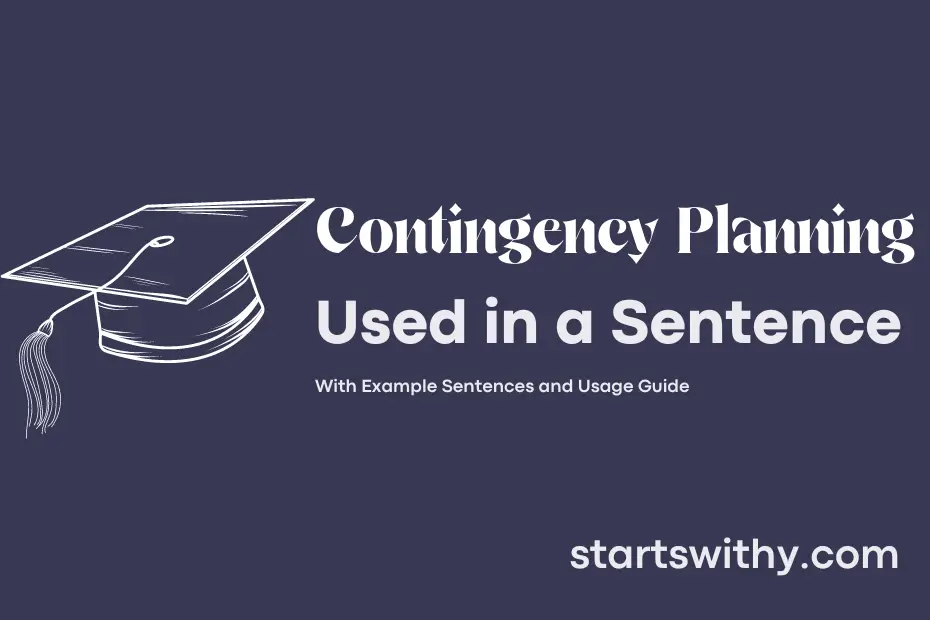Contingency planning is a proactive strategy implemented by individuals or organizations to prepare for potential unexpected events or situations. It involves developing detailed plans and protocols to address and mitigate the impacts of various unforeseen circumstances that could disrupt normal operations.
By creating contingency plans, individuals and organizations can minimize downtime, protect assets, and maintain business continuity in the face of emergencies such as natural disasters, technical failures, or economic downturns. These plans typically outline alternative courses of action, allocate necessary resources, and establish clear communication channels to ensure a swift and coordinated response when unforeseen events occur.
7 Examples Of Contingency Planning Used In a Sentence For Kids
- Contingency planning is like preparing for different situations.
- We can make a plan for emergencies with contingency planning.
- Contingency planning helps us be ready for anything unexpected.
- It’s important to have a contingency planning in place always.
- Let’s think about what we can do with contingency planning if something goes wrong.
- With contingency planning, we can stay safe and prepared.
- We should practice our contingency planning regularly.
14 Sentences with Contingency Planning Examples
- Contingency planning is essential for college students in case of sudden power outages during online exams.
- Unexpected internet connectivity issues can be managed through effective contingency planning.
- Having a backup study location is a key aspect of successful contingency planning for college students.
- It is important to include financial emergencies in your contingency planning as a college student.
- Contingency planning should also cover health emergencies, such as sudden illness during exam week.
- Having extra supplies and resources in case of a campus lockdown is part of effective contingency planning.
- Transportation breakdowns can be managed with proper contingency planning for college students.
- Consider including mental health resources and support in your contingency planning for smoother college life.
- In the event of class cancellations, having an alternative study schedule in place showcases good contingency planning.
- Incorporating virtual learning tools in your contingency planning prepares you for unexpected shifts to online classes.
- Adequate preparation for unexpected roommate conflicts is a sign of thoughtful contingency planning by college students.
- To handle sudden assignment extensions, effective contingency planning with alternate deadlines is crucial.
- Including a list of emergency contacts in your contingency planning ensures quick support during crises.
- Contingency planning for unexpected weather conditions like heavy rain or storms can prevent disruptions in your college schedule.
How To Use Contingency Planning in Sentences?
Contingency planning is a crucial process for ensuring a company’s resilience during unexpected events. To start, identify potential risks that could disrupt your operations, such as natural disasters, supply chain issues, or market fluctuations. Next, assess the likelihood and potential impact of each risk to prioritize your planning efforts.
Once you have identified and assessed the risks, it’s time to develop strategies to mitigate them. This could involve creating backup plans, establishing communication protocols, or investing in insurance coverage. Remember to involve key stakeholders in the planning process, as their input can provide valuable insights and help ensure buy-in across the organization.
After developing your contingency plans, it’s important to regularly review and update them to reflect changes in your business environment. This could include new risks emerging, changes in regulations, or shifts in market conditions. Consider conducting drills or simulations to test the effectiveness of your plans and make any necessary adjustments.
In the event of an actual crisis, refer to your contingency plans for guidance on how to respond. Stay calm, follow the established protocols, and communicate clearly with your team and stakeholders. Evaluate the effectiveness of your response after the crisis has passed and use this feedback to improve your contingency planning process for the future. By following these steps, you can better prepare your organization for unforeseen events and minimize their impact on your operations.
Conclusion
Contingency planning is crucial for organizations to prepare for unexpected events and ensure business continuity. By creating a series of sentences with contingency planning, it becomes evident that thorough preparation is essential in various scenarios, such as natural disasters, economic downturns, or cyber attacks. These examples serve as a reminder of the importance of anticipating and mitigating potential risks to minimize disruptions and facilitate a swift response in times of crisis.
In essence, the various sentences with contingency planning highlight the need for organizations to have flexible strategies in place that can adapt to unforeseen circumstances. It is clear that proactive planning and readiness are key elements in safeguarding operations and mitigating the impact of unforeseen events, ultimately allowing businesses to navigate challenges more effectively and maintain resilience in the face of uncertainty.



